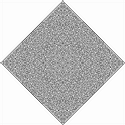The Death Star
Saturday, December 6th, 2003Cool RSS feed of the day: MarsNews - the XML version didn’t work for me, but the RDF was fine
I stumbled over The Nemesis Affair while looking for The Case for Mars in the library. The former tells the tale of the 26-million-year cyclic theory of extinctions proposed by David Raup and Jack Sepkoski in the early 80’s. The statistics themselves have never been convincingly disproven; the dinosaurs had an appointment with death and ours is coming up in 15 million years.
Even without Nemesis, the theory was already controversial. It seems that paleo paleontologists preferred a steady-state theory of extinction - the dinosaurs were on their way out anyway. It’s hard for outsiders like us to believe that in a field (paleontology) in which the eons have always been separated by massive extinctions that there would be so much disbelief in mass extinction per se. Setting it to a bouncy 26 m.y. beat did not go over well in the scientific community. Likewise, no one believed in Deep Impact-style meteor impacts twenty years ago; today we take the sky falling for granted.
Despite being largely about that sort of scientific infighting and malingering, The Nemesis Affair was a good, quick read. Given the pretty pictures of extinction cycles (you can see one partway down this science beat page), the question immediately arises, who’s tossing meteors at us?
Three answers were suggested: Nemesis, Planet X, and the galactic plane. The mechanism was more or less the same in each case - every 26 to 30 million years, the menace passes through the Oort Cloud and disturbs the comets, many of which come screeching in towards the sun. On their new orbits, a comet or two may slam into the Earth (or any other innocent bystander planet), punching holes on the order of the 200-km wide Chicxulub crater, blocking out the sun with aerosolized bits of the Yucatan, and killing off the dinosaurs. The stray meteors don’t have to do us on their first pass - the cycle is measured in millions of years. Two out of the last twelve cataclysmic cycles resulted in no appreciable extinctions - ergo, the strays may even miss us all together.
So about the culprits… Our sun passes up and down through the plane of the galaxy like a yo-yo every 30 million years or so (65 million years round-trip), presumably encountering more dust and stuff while in the denser plane than when above or below it. It’s not clear how the dust does its damage or where those space dust bunnies are located. Planet X is the long-lost tenth planet that was supposed to balance the wobbles in the orbits of the outer planets. It’s no longer so clear that those orbits wobble at all. Nemesis is a postulated dim companion star that travels halfway to Alpha Centauri when it’s not busy wiping out Terran life. The failure of the IRAS survey to find a suitable star nearby has put a dent in the Nemesis theory, but at least one scientist still believes.
The Death Star may still be out there…and if it’s not, then who’s tossing those meteors at us?
